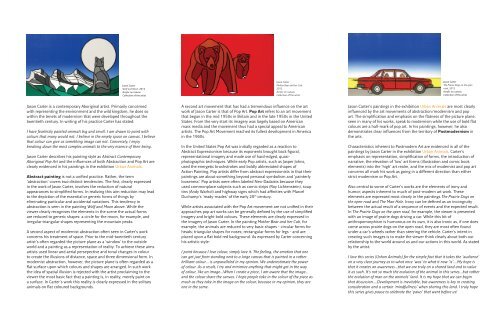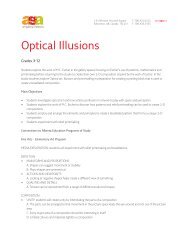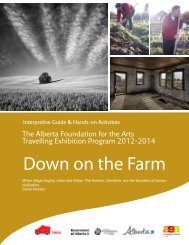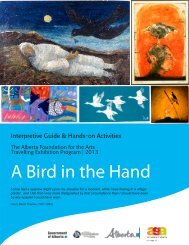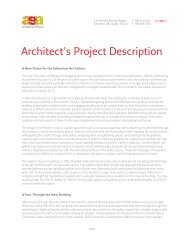Urban Animals Urban Animals - Art Gallery of Alberta
Urban Animals Urban Animals - Art Gallery of Alberta
Urban Animals Urban Animals - Art Gallery of Alberta
You also want an ePaper? Increase the reach of your titles
YUMPU automatically turns print PDFs into web optimized ePapers that Google loves.
Jason Carter<br />
Wolf and Moon, 2012<br />
Acrylic on canvas<br />
Collection <strong>of</strong> the artist<br />
Jason Carter<br />
Mother Bear and her Cub,<br />
2012<br />
Acrylic on canvas<br />
Collection <strong>of</strong> the artist<br />
Jason Carter<br />
The Prairie Dogs on the open<br />
road, 2012<br />
Acrylic on canvas<br />
Collection <strong>of</strong> the artist<br />
Jason Carter is a contemporary Aboriginal artist. Primarily concerned<br />
with representing the environment and the wild kingdom, he does so<br />
within the tenets <strong>of</strong> modernism that were developed throughout the<br />
twentieth century. In writing <strong>of</strong> his practice Carter has stated:<br />
I have fearlessly painted animals big and small. I am drawn to paint with<br />
colours that many would not. I believe in the empty space on canvas. I believe<br />
that colour can give us something image can not. Conversely, I enjoy<br />
breaking down the most complex animals to the very essence <strong>of</strong> their being.<br />
Jason Carter describes his painting style as Abstract Contemporary<br />
Aboriginal Pop <strong>Art</strong> and the influences <strong>of</strong> both Abstraction and Pop <strong>Art</strong> are<br />
clearly evidenced in his paintings in the exhibition <strong>Urban</strong> <strong>Animals</strong>.<br />
Abstract painting is not a unified practice. Rather, the term<br />
‘abstraction’ covers two distinct tendencies. The first, clearly expressed<br />
in the work <strong>of</strong> Jason Carter, involves the reduction <strong>of</strong> natural<br />
appearances to simplified forms. In realizing this aim reduction may lead<br />
to the depiction <strong>of</strong> the essential or generic forms <strong>of</strong> things by<br />
eliminating particular and accidental variations. This tendency in<br />
abstraction is seen in the painting Wolf and Moon above. While the<br />
viewer clearly recognises the elements in the scene the actual forms<br />
are reduced to generic shapes: a circle for the moon, for example, and<br />
irregular triangular shapes representing the mountain peaks.<br />
A second aspect <strong>of</strong> modernist abstraction <strong>of</strong>ten seen in Carter’s work<br />
concerns his treatment <strong>of</strong> space. Prior to the mid-twentieth century<br />
artist’s <strong>of</strong>ten regarded the picture plane as a ‘window’ to the outside<br />
world and a painting as a representation <strong>of</strong> reality. To achieve these aims<br />
artists used linear and aerial persepective and tonal changes in colour<br />
to create the illusions <strong>of</strong> distance, space and three dimensional form. In<br />
modernist abstraction, however, the picture plane is <strong>of</strong>ten regarded as a<br />
flat surface upon which colours and shapes are arranged. In such work<br />
the idea <strong>of</strong> spatial illusion is rejected with the artist proclaiming to the<br />
viewer the most basic fact that a painting is, in reality, merely paint on<br />
a surface. In Carter’s work this reality is clearly expressed in the solitary<br />
animals on flat coloured backgrounds.<br />
A second art movement that has had a tremendous influence on the art<br />
work <strong>of</strong> Jason Carter is that <strong>of</strong> Pop <strong>Art</strong>. Pop <strong>Art</strong> refers to an art movement<br />
that began in the mid 1950s in Britain and in the late 1950s in the United<br />
States. From the very start its imagery was largely based on American<br />
mass media and the movement thus had a special appeal to American<br />
artists. The Pop <strong>Art</strong> Movement reached its fullest development in America<br />
in the 1960s.<br />
In the United States Pop <strong>Art</strong> was initially regarded as a reaction to<br />
Abstract Expressionism because its exponents brought back figural,<br />
representational imagery and made use <strong>of</strong> hard-edged, quasiphotographic<br />
techniques. While early Pop artists, such as Jasper Johns,<br />
used the energetic brushstrokes and boldly abbreviated shapes <strong>of</strong><br />
Action Painting, Pop artists differ from abstract expressionists in that their<br />
paintings are about something beyond personal symbolism and ‘painterly<br />
looseness’. Pop artists were <strong>of</strong>ten labeled Neo-Dadaists because they<br />
used commonplace subjects such as comic strips (Roy Lichtenstein), soup<br />
tins (Andy Warhol) and highway signs which had affinities with Marcel<br />
Duchamp’s ‘ready-mades’ <strong>of</strong> the early 20 th century.<br />
While artists associated with the Pop <strong>Art</strong> movement are not unified in their<br />
approaches pop art works can be generally defined by the use <strong>of</strong> simplified<br />
imagery and bright bold colours. These elements are clearly expressed in<br />
the imagery <strong>of</strong> Jason Carter. In the painting Mother Bear and her Cub, for<br />
example, the animals are reduced to very basic shapes - circular forms for<br />
heads; triangular shapes for noses; rectangular forms for legs - and are<br />
placed upon a flat bold red background. As expressed by Carter concerning<br />
his artistic style:<br />
I paint because I love colour, simply love it. The feeling, the emotion that one<br />
can get just from standing next to a large canvas that is painted in a rather<br />
brilliant colour... is unparalleled in my opinion. We underestimate the power<br />
<strong>of</strong> colour. As a result, I try and minimize anything that might get in the way<br />
<strong>of</strong> colour, like an image...When I create a piece, I am aware that the image...<br />
and the colour share the canvas. I hope people take in the colour <strong>of</strong> the piece as<br />
much as they take in the image on the colour, because in my opinion, they are<br />
one in the same.<br />
Jason Carter’s paintings in the exhibition <strong>Urban</strong> <strong>Animals</strong> are most clearly<br />
influenced by the art movements <strong>of</strong> abstraction/modernism and pop<br />
art. The simplification and emphasis on the flatness <strong>of</strong> the picture plane,<br />
seen in many <strong>of</strong> his works, speak to modernism while the use <strong>of</strong> bold flat<br />
colours are a hall-mark <strong>of</strong> pop art. In his paintings, however, he also<br />
demonstrates clear influences from the territory <strong>of</strong> Postmodernism in<br />
the arts.<br />
Characteristics inherent to Postmodern <strong>Art</strong> are evidenced in all <strong>of</strong> the<br />
paintings by Jason Carter in the exhibition <strong>Urban</strong> <strong>Animals</strong>. Carter’s<br />
emphasis on representation, simplification <strong>of</strong> forms, the introduction <strong>of</strong><br />
narrative, the elevation <strong>of</strong> ‘low’ art forms (illustration and comic book<br />
elements) into the ‘high’ art realm, and the mix <strong>of</strong> modernist and pop art<br />
concerns all mark his work as going in a different direction than either<br />
strict modernism or Pop <strong>Art</strong>.<br />
Also central to some <strong>of</strong> Carter’s works are the elements <strong>of</strong> irony and<br />
humor; aspects inherent to much <strong>of</strong> post-modern art work. These<br />
elements are expressed most clearly in the paintings The Prairie Dogs on<br />
the open road and The Man Hole. Irony can be defined as an incongruity<br />
between the actual result <strong>of</strong> a sequence <strong>of</strong> events and the expected result.<br />
In The Prairie Dogs on the open road, for example, the viewer is presented<br />
with an image <strong>of</strong> prairie dogs driving a car. While this bit <strong>of</strong><br />
anthropomorphism is humorous on its own, it is also ironic as, if one does<br />
come across prairie dogs on the open road, they are most <strong>of</strong>ten found<br />
under a car’s wheels rather than steering the vehicle. Carter’s intent in<br />
creating such images is to make the viewer think clearly about both our<br />
relationship to the world around us and our actions in this world. As stated<br />
by the artist:<br />
I love this series (<strong>Urban</strong> <strong>Animals</strong>) for the simple fact that it takes the ‘audience’<br />
on a very clear journey as to what once ‘was’ to what it now ‘is’....My hope is<br />
that it creates an awareness...that we are truly on a shared land and to value<br />
it as such. It’s not so much the evolution <strong>of</strong> the animal in this series...but rather<br />
the evolution <strong>of</strong> man on the animals’ land. It is my hope that we can begin<br />
that discussion....Development is inevitable, but awareness is key in creating<br />
consideration and a certain ‘mindfullness’ when sharing this land. I truly hope<br />
this series gives pause to celebrate the ‘paws’ that went before us!


